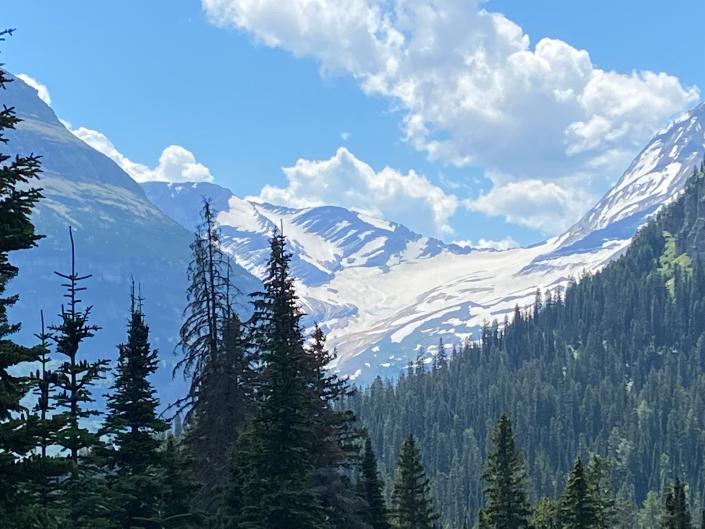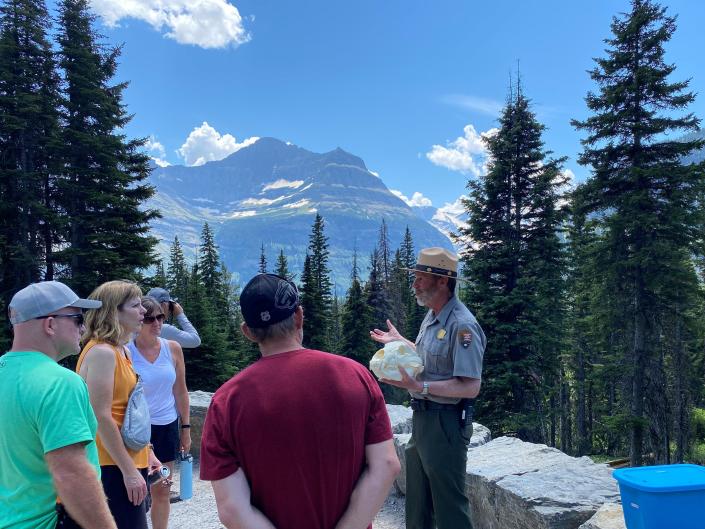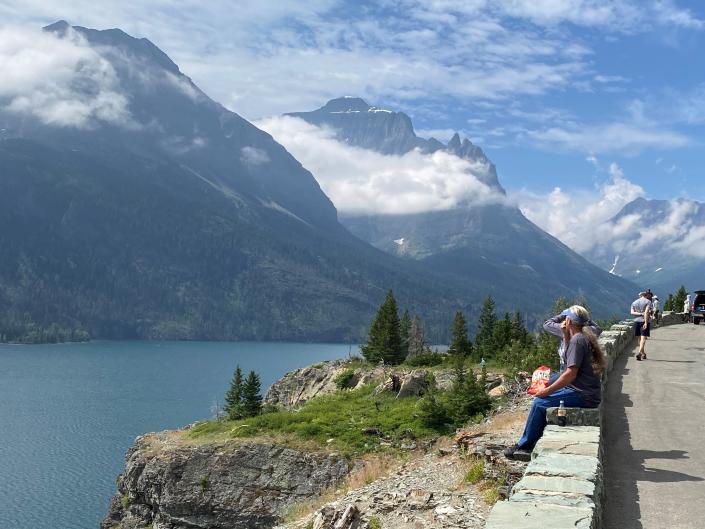[ad_1]
GLACIER NATIONAL PARK, Mont. – Guests stride into the grand lobby of the Many Glacier Hotel, once the largest hotel in Montana, and head toward the balconies overlooking Swiftcurrent Lake and Grindell Point. They breathe in pine-scented air, cooled by the glaciers cloaking the surrounding mountains. The visitors are transported back to an era when a visit to Glacier National Park was considered a royal audience with nature.
The million-acre park in northwestern Montana at the Canadian border holds 175 mountains, 762 lakes, 563 streams and uncountable sights of immense wilderness. The national park welcomes more than 3 million visitors a year despite its remoteness and with the weather limiting most visits to May through September.
Capturing the splendor

The Many Glacier Hotel, on the east side of Glacier National Park, enhances a visitor’s experience by its perfect location across from Grinnell Point. Serenity and grandeur envelop all who sit on its balconies or wander along the lakeshore in hopes of moose or bear sightings.
The hotel opened in 1915, just five years after Glacier became a national park. The Great Northern Railroad built it at a time when the national park was promoted as “America’s Switzerland.” As if it were lifted directly from the Swiss Alps, the chalet-style hotel features a low-pitched roof, many gables and white-framed windows.
Explore: Nature defines western New England, from Lake Champlain to Berkshires
Travel: Gilded Age mansions to FDR’s picnics, Hudson Valley captures pastoral state
The aging structure faced demolition in the early 2000s, but instead, a $42 million renovation was completed in 2017, and now guests experience the classic rustic ambience, just as visitors did many decades ago. In the lobby, guests are captivated by the tall Douglas fir supports, glowing lanterns and double helix staircase. They socialize in convivial seating areas and meet in the Ptarmigan Dining Room, a setting with vaulted ceiling, heavy beams, massive stone fireplace and large windows offering expansive views of the magnificent scenery.
From the hotel’s dock, visitors paddle canoes and climb aboard the cruise boat Chief Two Guns for leisurely excursions. In addition to a nature trail around the lake, other hiking routes, such as the Swiftcurrent Trail to Redrock Lake and the Apikuni Falls Trail, are close by.
Sightseeing at its finest

In Glacier National Park, the Going-to-the-Sun Road crosses the midsection and showcases a range of landscapes as diverse as they are dazzling. Moments after driving past the St. Mary Visitor Center, natural beauty overwhelms at every turn. Most of the 50-mile motor route’s eastern half is a drive along bright blue St. Mary Lake. The overlook toward Wild Goose Island delivers the best view with a collection of razor-sharp peaks lined up like sentries across the horizon.
At 10,000 feet in altitude, Mount Jackson holds two of the national park’s 25 glaciers: Jackson and Harrison. Seasoned hikers take on the day-long challenge of scaling it; however, the Jackson Glacier Overlook on the Going-to-the-Sun Road provides a glorious view without the trek.
More trips: Hot Springs, Arkansas, evolves from shady past into a relaxing destination
More travel: Little Rock is in the center of everything in Arkansas
The visitor center at Logan Pass draws a crowd. At 6,646 feet, Logan Pass is the highest point in the park reachable by car and sits squarely on the Continental Divide. Bicyclists who take on the steep inclines frequently stop for a rest here. A big attraction for hikers is the Hidden Lake Trail which spans an alpine meadow and a glacier field before leading to an overlook of the lake and Bearhat Mountain. Bighorn sheep, mountain goats, hoary marmots, grizzly bear and white-tailed deer inhabit the slopes. Wildflowers, including glacier lily, Lewis’s monkeyflower and moss campion, grow in abundance.
As motorists continue west, they notice changes in the landscape. An alpine forest of Douglas firs, hemlocks and aspens transitions to a lusher, more varied ecosystem of trees and flowers. At the Trail of the Cedars, hikers follow a mile-long loop through a forest of ancient, 200-foot-tall cedar trees. Water roars down Avalanche Gorge, and the denseness of the vegetation provides the feel of a rainforest.
Still farther west along the Going-to-the-Sun Road, visitors make stops at two roaring waterfalls, McDonald Falls and Sacred Dancing Cascade. Before long, the national park’s largest and deepest lake comes into view. The 10-mile-long Lake McDonald runs parallel to the road for several miles. Here, another notable historic accommodation, the Lake McDonald Lodge, provides a haven for tired and hungry travelers, as it has for more than a century.
Comfort steeped in history

Lake McDonald Lodge, a year older than the Many Glacier Hotel, also was built in the Swiss-influenced architectural style. The three-story lobby, framed by heavy timbers, displays a collection of furry taxidermy mounts, original handcrafted furnishings and Native American art pieces. Visitors note the prominently placed messages in the Kootenai dialect: “welcome” and “new life to those who drink here.” Guests sit in cushioned chairs, perhaps play checkers, and immerse themselves in the national park’s history.
Wrapped in the fresh fragrance of pine and cedar, the lodge complex includes rustic, yet very comfortable, cabins. Like the lodge, the timber cabins have hand-hewn furniture, Native American motif-décor, and outdoor-themed accessories. Guests enjoy moments of unhurried leisure on their private porches.
Many people at Lake McDonald Lodge delve deeper into the classic, old-time vacation experience by riding in one of the red “jammer” buses, some dating back to the 1930s. These signature vehicles transport tourists on narrated tours. Also, visitors climb aboard DeSmet, a boat that departs five times a day for guided tours. Canoes, kayaks and paddleboards are available for rent at the dock. Horseback riders depart from nearby stables for journeys into the heart of the national park.
Red bus tours can also be boarded at the national park’s other lodging options, including Apgar on the far west end of the Going-to-the-Sun Road. The family-oriented village includes a lodge, cabins, café, general store and ice cream parlor. Hikers have easy access to the Lake McDonald West Shore Trail, and bicyclists are near the Fish Creek and Apgar bike paths. The Fish Creek Campground is close by.
Linda Lange and Steve Ahillen are travel writers living in Knoxville, Tenn.
This article originally appeared on Knoxville News Sentinel: Visit Glacier National Park in Montana for The Many Glacier Hotel
[ad_2]
Source link











